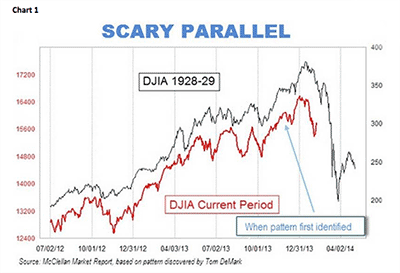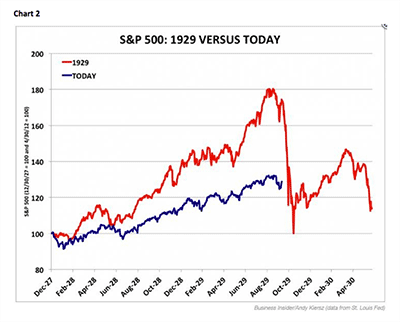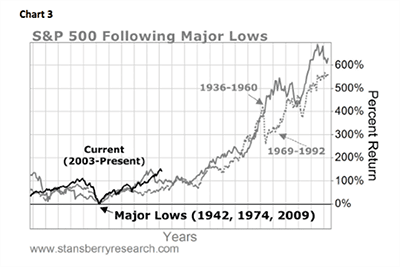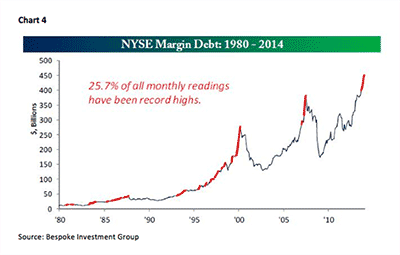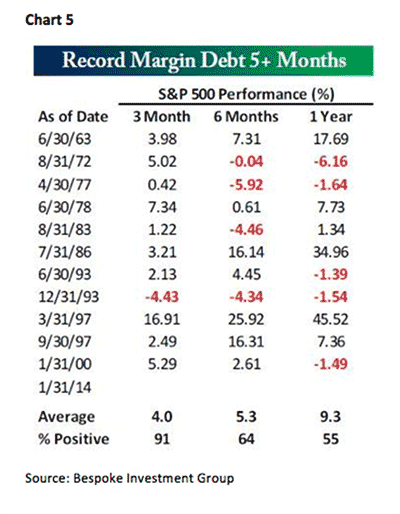“A Kid’s Market?”
by Jeffrey Saut, Chief Investment Strategist, Raymond James
March 17, 2014
“My solution to the current market,” the Great Winfield said ... kids. “This is a kids’ market. This is Billy the Kid, Johnny the Kid, and Sheldon the Kid. Aren’t they cute?” the Great Winfield asked. “Aren’t they fuzzy? Look at them, like teddy bears. It’s their market. I have taken them on for the duration. I give them a little stake, they find the stocks, and we split the profits,” he said. “Billy the Kid here started with five thousand dollars and has run it up over half a million in the last six months.” “Wow!” I said. I asked Billy the Kid how he did it.
“Computer leasing stocks, sir!” he said, like a cadet being quizzed by an upper classman. “The need for computers is practically infinite,” said Billy the Kid. “Leasing has proved the only way to sell them, and computer companies themselves do not have the capital. Therefore, earnings will be up a hundred percent this year, will double next year, and will double again the year after. The surface has barely been scratched. The rise has scarcely begun.”
“Look at the skepticism on the face of this dirty old man,” said the Great Winfield, pointing at me. “Look at him, framing questions about depreciation, about how fast these computers are written off. I know what he’s going to ask. He’s going to ask what makes a finance company worth fifty times earnings. Right?” “Right,” I admitted. Billy the Kid smiled tolerantly, well aware that the older generation has trouble figuring out the New Math, the New Economics, and the New Market. “You can’t make any money with questions like that,” said the Great Winfield. “They show you’re middle-age, they show your generation. Show me a portfolio, I’ll tell you the generation. See? See?” said the Great Winfield. “The flow of the seasons! Life begins again! It’s marvelous! It’s like having a son! My boys! My kids!”
... “The Money Game” by Adam Smith
The Great Winfield goes on to say, in Adam Smith’s classic book from 1967, “The strength of my kids is that they’re too young to remember anything bad, and they are making so much money they feel invincible.” He rented kids with the idea that one day the music will stop (it partially did in 1969-1970 and completely did in 1973-1974) and all of them will be broke but one. That one survivor will be the Arthur Rock (legendary venture capitalist) of the new generation; Winfield will keep him. Obviously, folks, I am back from my six-week sojourn of seeing portfolio managers (PMs) where it became abundantly clear that the “kids” are currently outperforming the stock market’s “greybeards” as the Warren Buffetts of the world worry about such silly things like valuations, waning earnings’ momentum, slow GDP growth, a housing slowdown, etc.
“The Kids Are Alright,” speaking to a movie about my misbegotten youth, is typical of many of the “kids” currently running money at many of the mutual funds du jour who have “no fear” of anything. The bubble that exists in the biotech space and many of the digital media stocks is a proof statement of “the kids!” That said, valuations are not particularly onerous with the P/E ratio for the S&P 500 (SPX/1841.13) currently trading around 15.2x this year’s bottom-up estimate of roughly $121 per share. Moreover, if next year’s estimates are anywhere near the mark of $137, the SPX is being valued at a mere 13.4x earnings. Meanwhile, investors are profoundly underinvested in U.S. equities given all of the good things that are going on like the American Industrial Renaissance, Energy Independence, and the potential for a change in the constituency of Congress (for the better) that was punctuated by what happened in last week’s elections here in Florida. Still, the negative nabobs seem to dominate the news. More recently, worries about the burgeoning margin debt have been making the rounds as a reason to expect another stock market crash, but in my view nothing is further from the truth. A few weeks ago it was the correlation to the 1929 stock market rally that led to the ’29 crash that made the rounds. I wrote about that, noting that the folks making said comparison were using ratio-adjusted charts, which can make the charts show just about anything you want them to. The same thing happened with Japan’s Nikkei Index in the early 1990s and that also proved to be wrong. Accordingly, the alleged pundits that called for a “crash” four weeks ago have, at least so far, also been proven wrong, which I discussed when dissecting their comparison chart to 1929 showing that when comparing apples-to-apples the correlation totally breaks down (see chart 1 and 2). In fact, as proof that you can make ratio charts do just about anything you want, take a look at chart 3 that suggests this secular bull market has another 300% to 400% left on the upside. Nevertheless, over the past few weeks I have again been “pounded” with the Margin Debt chart showing margin debt at an all-time high, leaving the negative nabobs predicting another stock market crash. Hereto, the argument does not hold up to scrutiny. As my friends at the must have Bespoke Investment Group write:
This week, the NYSE released its latest figures on margin debt, which increased for the seventh straight month. January’s increase also marked the fifth straight month that margin debt hit a record high. As margin debt has been hitting record highs for the last five months, the number of articles citing this as a sign of a market top has been rising just as steadily. The key thing to remember when you read any of these articles, though, is that while peaks in the equity market have occurred when margin debt was at a record high, most record levels of margin debt are not accompanied by a market decline. The nearby chart (chart 4) shows margin debt levels on the NYSE going back to 1980. In the chart, everywhere the line is red indicates that margin debt levels are at a record high. As you can see, there is a lot of red in the chart. In fact, more than 25% of all monthly readings in margin debt since 1980 have been record levels. In other words, record levels of margin debt are more than a little common. A lot of the recent articles surrounding record levels of margin debt have suggested it is a sign of a market peak. The reality, though, is that equities have tended to see positive returns following periods of record margin debt levels. The table (chart 5) to the right lists each of the prior 11 periods where margin debt hit a record high for five consecutive months as it has done in the last five months. For each period, we then calculated the S&P 500’s return in the following 3, 6, and 12 months. Over the following three months, the S&P 500 has averaged a gain of 4.0% with positive returns 91% of the time. Over the following six months, the average change is a gain of 5.3% with positive returns just under two-thirds of the time, and over the next year, the S&P 500 has averaged a gain of 9.3% with positive returns 55% of the time. While we wouldn’t go so far as to say that record margin debt levels are a buying signal, history has shown that record margin debt levels have not been a very good sell signal either.
As for the stock market, I began 2014 stating that following the 40%+ rally the SPX had experienced since June of 2012, history suggested a 5% - 7% pullback was due sometime in the next three months and a 10% - 12% decline was due to begin sometime over the next 12 months. Almost on cue the SPX made an outside reversal that led to a 6.2% decline that culminated on February 5th with an intraday “print low” of 1737.92. We experienced a similar chart pattern last Tuesday whereby the SPX, D-J Industrial Average (INDU/16065.67), NASDAQ 100 (NDX/3627.87), Banks (BKX/$69.54), the Broker/Dealers (XBD/$158.88), and others had downside outside reversal days. Recall, a downside outside reversal is when the security’s high and low price for the session BOTH exceed those of the previous session. While it is too soon to determine what the impact, or extent, of any potential decline is going to be, it is a reason to continue in a cautious mode for the near-term. Of course, the news from the Russia situation should have an impact in the short-run.
The call for this week: “From Russia with Love” is currently the movie du jour playing on the world’s screens because yesterday, in an alleged “free” election, Crimea voted to reconnect with Russia. A vote by Russia’s Duma to approve that annexation should happen by Friday. This probably means a coordinated sanction statement from the G7 will come today. Somewhat surprisingly, this morning all the preopening futures are in the green (SPX +11), which seems appropriate for St. Patrick’s Day. There remains support for the SPX at 1835 – 1840, and the McClellan Oscillator is very oversold. Yet, today’s early morning strength, in light of Crimea, is interesting and confusing. As my friends at the sagacious GaveKal organization write, “Bertrand Russell once quipped that ‘wars are not won by who is right, but by who is left.’ With that in mind, markets should welcome the result of yesterday’s referendum in the Crimea. After all, had the result been ambiguous then fanatics on either side of the divide may have been tempted to take up arms to settle the issue. However, with the vox populi confirming the ‘way of the strong,’ Anatole argues that the whole Ukraine problem is now more likely to be resolved without much further confrontation.”






